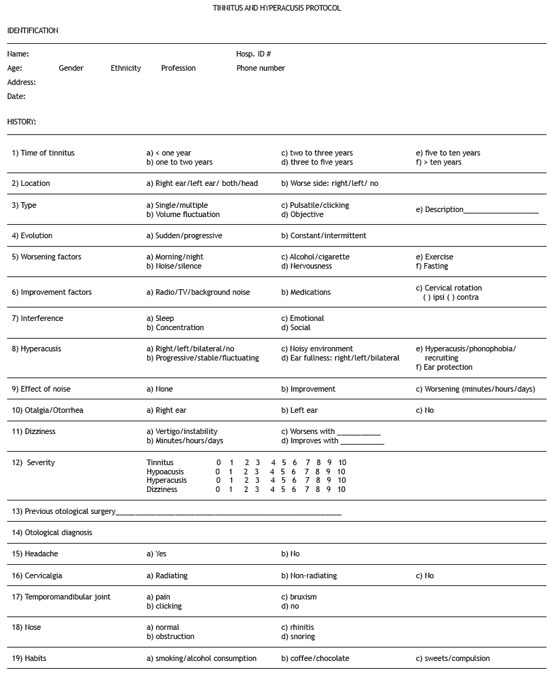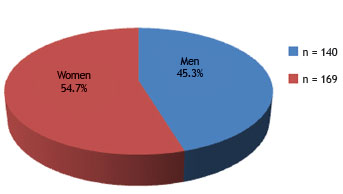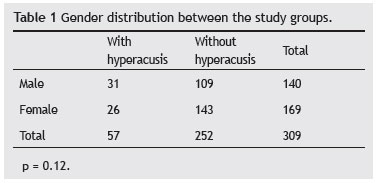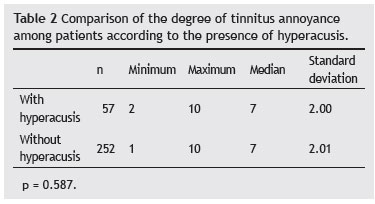

Year: 2014 Vol. 80 Ed. 1 - (7º)
Artigo Original
Pages: 24 to 28
Study of the relationship between the degree of tinnitus annoyance and the presence of hyperacusis
Author(s): Alexandre Caixeta Guimarães1; Guilherme Machado de Carvalho1; Márcia Maria de Freitas Dias Voltolini2; Carlos Eduardo Monteiro Zappelini1; Raquel Mezzalira1; Guita Stoler1; Jorge Rizzato Paschoal1
DOI: 10.5935/1808-8694.20140007
Keywords: Tinnitus; Hyperacusis; Audiometry; Hearing disorders
Abstract:
INTRODUCTION: Hyperacusis can be defined as a manifestation of an increased of central auditory pathways gain and can be considered a pre-tinnitus state. In some cases tinnitus may be can be caused by such increased gain.
AIM: To evaluate the prevalence of hyperacusis in patients with tinnitus and its relation to the annoyance of tinnitus.
MATERIALS AND METHODS: Retrospective study with patients from the neurotology service complaining of tinnitus in the first consultation were submitted to clinical evaluation, a questionnaire and audiological evaluation of tinnitus and hyperacusis. The degree of annoyance of tinnitus and hyperacusis was measured using a visual analog scale.
RESULTS: We analyzed medical records of 309 patients, 169 (54.7%) females and 140 (45.3%) males. The mean age was 53 years. The median degree of tinnitus annoyance was 7. Hyperacusis was present in 57 (18.4%) patients, with a median degree of five. The degree of annoyance due to tinnitus patients with hyperacusis was similar to that of patients without hyperacusis.
CONCLUSION: Hyperacusis was present in 18.4% of patients with tinnitus. The degree of annoyance due to tinnitus had no correlation with the presence of hyperacusis.
![]()
INTRODUCTION
Tinnitus is defined as the perception of sound in the absence of an external generating source.1,2 It affects between 14% and 32% of the population,3 and can have a negative impact on quality of life, and interfere with concentration, sleep, social activities, and even the emotional stability.1,4,5 It is a complex symptom, as it is usually associated with other neurotological complaints, such as hearing loss, dizziness, and hyperacusis.2
Hyperacusis is hypersensitivity to sound, in which a common sound stimulus is perceived as extremely intense or uncomfortable.6 Jastreboff and Hazell defined hyperacusis as the manifestation of increased gain in the central pathways of the auditory system, considering it a pre-tinnitus state; in some cases, tinnitus may be secondary to this increased gain.7 The higher prevalence of hyperacusis in tinnitus patients, even in the absence of hearing loss, suggests that there is a common origin for these two symptoms. Both hyperacusis and tinnitus would originate from the increased gain in the central auditory pathways; tinnitus would result from a spontaneous central gain and hyperacusis from the central gain through a sound stimulus.8-10
There are different methods for assessing tinnitus annoyance and hyperacusis, from numerical scales to visual analog scales (VAS). The Tinnitus Handicap Inventory (THI) is the most accepted method for assessing tinnitus, since it is easy to apply and interpret and because it addresses several aspects of patient quality of life.11,12 However, previous studies have shown that VAS, in which the patient grades the tinnitus annoyance from 1-10, has a good correlation with THI.11-15
The annoyance caused by tinnitus can be quite variable, and there are certain factors that appear to be associated with a higher degree of discomfort, such as the presence of stress, psychiatric disorders,16,17 and female gender.18-20 Age also appears to be correlated with the degree of tinnitus annoyance, as it is worse in patients older than 50 years.21 Another study demonstrated that the group aged between 45 and 59 years had a higher degree of annoyance than younger or older patients.19
The association between hyperacusis and tinnitus is still unclear. There have been studies that observed no association between the presence of hyperacusis and degree of tinnitus annoyance,20,22 and others in which tinnitus annoyance was higher in patients with hyperacusis.21,23
This study aimed to evaluate the prevalence of hyperacusis in tinnitus patients and its association with the degree of tinnitus annoyance.
MATERIAL AND METHODS
This study included patients from the neurotology outpatient clinic of a tertiary university hospital, treated in the last eight years with a chief complaint of tinnitus in the first consultation. All patients answered a questionnaire and underwent clinical and audiological evaluations. The questionnaire aimed to characterize the type, presence of unilateral or bilateral tinnitus, and presence and degree of annoyance of hyperacusis, among other information (Fig. 1). The clinical examination included neurological and otorhinolaryngological assessment, whereas the audiological evaluation consisted of tonal audiometry, logoaudiometry, and immitanciometry.
Figure 1 Questionnaire used to assess patients with tinnitus. In addition to the questionnaire, the patient also graded the degree of tinnitus annoyance and hyperacusis based on the visual analogue scale.
The study excluded patients with para-auditory tinnitus, presence of infectious disease in the middle or external ear undergoing treatment, and incomplete questionnaires.
The degree of tinnitus and hyperacusis annoyance was classified using the VAS (Fig. 2). Statistical analysis was performed using the Statistical Package for Social Sciences (SPSS), release 19. Nonparametric Mann-Whitney's test was performed to evaluate the correlation between tinnitus annoyance and hyperacusis, whereas the chi-squared test was used to assess the presence of hyperacusis according to gender. A p-value < 0.05 was considered significant.
Figure 2 Visual analog scale model used. The higher the numerical scale, the worse the level of discomfort.
The study was approved by the research ethics committee of the institution, under protocol No. 914/2011.
RESULTS
The medical records of 309 patients were analyzed; 169 (54.7%) patients were females and 140 (45.3%) were males (Fig. 3). The age ranged from 17 to 90 years, with a median of 52 years.
Figure 3 Gender distribution of patients with tinnitus. The chart illustrates the distribution of patients by gender, with 140 men and 169 women.
The degree of tinnitus annoyance ranged from 1 to 10, with a median of 7 (minimum of 1 and maximum of 10). In 186 (60.2%) patients, tinnitus was present bilaterally, in 46 (14.9%) only in the right ear, and in 77 (24.9%) only in the left ear.
Hyperacusis was present in 57 (18.4%) patients, at an intensity ranging from 1 to 10 and a median of 5. The presence of hyperacusis was more frequent in the male gender; 31 (22.4%) men and 26 (15.3%) women. There was no statistically significant difference between genders (p = 0.12) (Table 1).
There was no significant correlation between the presence of hyperacusis and degree of tinnitus annoyance; the latter was similar in patients with hyperacusis and in those without, with a median of 7 in both groups (p = 0.587) (Table 2).
DISCUSSION
Hyperacusis can occur in various conditions such as after stapedectomy,24 an episode of facial paralysis,25 acoustic trauma,26 and in individuals with normal or decreased hearing.
Hyperacusis is more frequently observed in patients with tinnitus.27 Its prevalence in such patients is quite variable, as there are many ways to evaluate hyperacusis, and the correlation between the means of assessment is generally low.6 Therefore, the prevalence of hyperacusis can range from 7.3% to 79% of patients with tinnitus.20,21,28-30
The association between tinnitus annoyance and presence of hyperacusis is controversial. Some authors observed no significant correlation between tinnitus severity and hyperacusis,20,22 while Goldstein et al. described this correlation in their study group.30 In a study of 37 patients, the degree of tinnitus annoyance rated by THI correlated with the presence of hyperacusis and sleep disorders.23 Another study demonstrated that the tinnitus intensity and annoyance were higher in patients with hyperacusis, vertigo, or hearing loss.21
In the present study of 309 patients, no correlation was observed between the presence of hyperacusis and degree of tinnitus annoyance, similarly to the studies by Dauman et al.20 and Magalhães et al.,22 although the latter used a four-grade scale for the classification of tinnitus annoyance and hyperacusis.
It is noteworthy that the present study evaluated patients with tinnitus, and hyperacusis was defined based on the anamnesis of these patients. No tests were performed, such as loudness discomfort level (LDL), as in other review articles on the subject.20-23 Other studies with hyperacusis defined by LDL that used other methods to assess the degree of discomfort may show different results than the present study.
The authors believe that further studies are needed to define the association between tinnitus annoyance and hyperacusis, which remains controversial.
CONCLUSION
Hyperacusis was present in 18.4% of patients with tinnitus. The degree of tinnitus annoyance in patients with hyperacusis was similar to that of patients without hyperacusis.
CONFLICTS OF INTEREST
The authors declare no conflicts of interest.
REFERENCES
1. Prestes R, Daniela G. Impact of tinnitus on quality of life, loudness and pitch match, and high-frequency audiometry. Int Tinnitus J. 2009;15:134-8.
2. Shulman A, Goldstein B. Principles of tinnitology: tinnitus diagnosis and treatment a tinnitus targeted therapy. Int Tinnitus J. 2010;16:73-85.
3. Hennig TR, Costa MJ, Urnau D, Becker KT, Schuster LC. Recognition of speech of normal-hearing individuals with tinnitus and hyperacusis. Int Arch Otorhinolaryngol. 2011;15:21-8.
4. Pinto PC, Sanchez TG, Tomita S. The impact of gender, age and hearing loss on tinnitus severity. Braz J Otorhinolaryngol. 2010;76:18-24.
5. Erlandsson SI, Holgers K. The impact of perceived tinnitus severity on health-related quality of life with aspects of gender. Noise Health. 2001;39:39-51.
6. Bläsing L, Goebel G, Flötzinger U, BertholdA, Kröner-Herwig B. Hypersensitivity to sound in tinnitus patients: an analysis of construct based on questionnaire and audiological data. Int J Audiol. 2010;49:518-26.
7. Jastreboff PJ, Hazell JWP. A neurophysiological approach to tinnitus: clinical implications. Br J Audiol. 1993;27:7-17.
8. Norena AJ. An integrative model of tinnitus based on a central gain controlling neural sensitivity. Neurosci Biobehav Rev. 2011;5:1089-109.
9. Schaette R, McAlpine D. Tinnitus with a normal audiogram: physiological evidence for hidden hearing loss and computational model. J Neurosci. 2011;31:13452-7.
10. Hébert S, Fournier P, Noreña A. The auditory sensitivity is increased in tinnitus ears. J Neurosci. 2013;33:2356-64.
11. Bahmad FM Jr, Venosa AR, Oliveira CA. Benzodiazepines and GABAergics in treating severe disabling tinnitus of predominantly cochlear origin. Int Tinnitus J. 2006;12:140-4.
12. Ferreira PEA, Cunha F, Onishi ET, Branco-Barreiro FCA, Ganança, FF. Tinnitus Handicap Inventory: adaptação cultural para o português brasileiro. Pro Fono. 2005;17:303-10.
13. Hallam RS, Jakes SC, Chambers C, Hinchcliff R. A comparison of different methods for assessing the intensity of tinnitus. Acta Otolaryngol. 1985;99:501-8.
14. Figueiredo RR, Azevedo AA, Oliveira PM. Correlation analysis of the visual-analogue scale and the Tinnitus Handicap Inventory in tinnitus patients. Braz J Otorhinolaryngol. 2009;75:76-9.
15. Kuk FK, Tyler RS, Russel D, Jordan H. The psychometric properties of a tinnitus handicap questionnaire. Ear Hear. 1990;11:434-45.
16. Langguth B, Kleinjung T, Fischer G, Hajak P, Eichhammer P, Sand PG. Tinnitus severity, depression and the big five personality traits. Prog Brain Res. 2007;166:221-7.
17. Seydel C, Haupt H, Szczepek AJ, Klapp BF, Mazurek B. Longterm improvement in tinnitus after modified tinnitus retraining therapy enhanced by a variety of psychological approaches. Audiol Neurootol. 2010;15:69-80
18. Valente JP, Pinheiro LA, Carvalho GM, Guimarães AC, Mezzalira R, Stoler G, et al. Evaluation of factors related to the tinnitus disturbance. Int Tinnitus J. 2012;17:21-5.
19. Seydel C, Haupt H, Olze H, Szczepek AJ, Mazurek B. Gender and chronic tinnitus: differences in tinnitus-related distress depend on age and duration of tinnitus. Ear Hear. 2013;34:661-72.
20. Dauman R, Bouscau Faure F. Assessment and amelioration of hyperacusis in tinnitus patients. Acta Otolaryngol. 2005;125:503-9.
21. Hiller W, Goebel G. Factors influencing tinnitus loudness and annoyance. Arch Otolaryngol Head Neck Surg. 2006;132:1323-9.
22. de Magalhães SL, Fukuda Y, Liriano RI, Chami FA, Barros F, Diniz FL. Relation of hyperacusis in sensorineural tinnitus patients with normal audiological assessment. Int Tinnitus J. 2003;9:79-83.
23. Fioretti AB, Fusetti M, Eibenstein A. Association between sleep disorders, hyperacusis and tinnitus: Evaluation with tinnitus questionnaires. Noise Health. 2013;15:91-5.
24. Mathisen H. Phonophobia after stapedectomy. Acta Otolaryngol. 1969;68:73-7.
25. Citron D, Adour KK. Acoustic reflex and loudness discomfort in acute facial paralysis. Arch Otolaryngol. 1978;104:303-6.
26. Axelsson A, Hamernik RP. Acute acoustic trauma. Acta Otolaryngol. 1987;104:225-33.
27. Coelho CB, Sanchez TG, Tyler RS. Hyperacusis, sound annoyance, and loudness hypersensitivity in children. Prog Brain Res. 2007;166:169-78.
28. Coles RRA, Sood SK. Hyperacusis and phonophobia in tinnitus patients. Br J Audio. 1998;22:228.
29. Jastreboff PJ, Gray WC, Gold SL. Neurophysiological approach to tinnitus patients. Am J Otol. 1996;17:236-40.
30. Goldstein B, Shulman A. Tinnitus - hyperacusis and the loudness discomfort level test - a preliminary report. Int Tinnitus J. 1996;2:83-9.
1. Universidade Estadual de Campinas (UNICAMP), Campinas, SP, Brazil
2. Departamento de Medicina da Aeronáutica, São Paulo, SP, Brazil
Corresponding author.
A.C. Guimarães
E-mail: alecgxl2@hotmail.com
Received 6 August, 2013.
Accepted 1 October, 2013.




